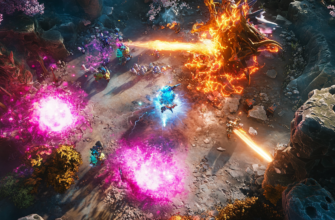- Understanding the key differences between first-person and third-person shooter games
- What is a first-person shooter? (FPS)
- Key features of first-person shooter games:
- What is a third-person shooter? (TPS)
- Key features of third-person shooter games:
- Breaking down the differences between FPS and TPS
- Immersion and immersion-breaking
- Gameplay and mechanics
- Situational awareness
- Cover systems
- Choosing the right shooter for your playstyle
- If you prefer fast-paced action:
- If you value strategy and awareness:
- Playstyles based on shooting mechanics
- Final verdict: your gaming experience, your choice!
- Let’s dive deeper!
Understanding the key differences between first-person and third-person shooter games
If you’re into shooter games, chances are you’ve come across both first-person and third-person perspectives. But have you ever wondered why some people favor one over the other? Does one give you an edge over the other? As your gaming bro, I’ve logged endless hours playing both types, and today, I’m going to break down the difference between first-person and third-person shooter games, so you can decide which one suits your style the best.
Whether you’re new to gaming or just looking for insight on why switching perspectives can change your overall experience, this article will dive into everything you need to know. So, let’s lock and load and get straight to it!
What is a first-person shooter? (FPS)
First things first, let’s define the basics. In a first-person shooter—commonly known as FPS—you experience the game from the protagonist’s point of view. The camera is planted directly into the eyes of your character, which means you only see what they see. Popular games like Call of Duty and Counter-Strike are excellent examples of this type of gaming. The action feels raw and immediate because you’re basically inside the character’s skin.
Key features of first-person shooter games:
- Immersion: Since you’re experiencing the game through the eyes of the character, FPS games offer a highly immersive experience.
- Precision aiming: Your weapon’s crosshair is crucial for taking down enemies, making precise aiming a key aspect of gameplay.
- Narrow field of view (FoV): You only see in front of your character, meaning situational awareness may be lower in chaotic environments.
- Adrenaline rush: Due to the personal perspective, there’s a heightened intensity, especially in multiplayer shootouts or close-quarters combat.
What is a third-person shooter? (TPS)
In contrast to FPS games, third-person shooters (TPS) let you view your character from an external viewpoint. The camera generally hovers behind your character, giving you a better sense of the surrounding environment. Games like Gears of War and Fortnite are perfect examples of TPS, where you not only see the action through your character’s eyes but also their body, attire, and movements. This external view is part of what makes third-person games more tactical for many players.
Key features of third-person shooter games:
- Wider field of view: The perspective allows you to see more of the environment around your character, which can help with situational awareness.
- Greater environmental interaction: The external camera gives you better environmental context, allowing for more dynamic movement and strategic positioning.
- Character customization: Since you constantly see your character, developers often emphasize more customization options, like skins or accessories.
- Control over aiming: TPS often requires a bit more finesse with aiming, as there’s a greater focus on environmental hazards and cover systems are more prevalent.
Breaking down the differences between FPS and TPS
If you’re choosing whether to get into first-person or third-person shooters, it really comes down to the style of gameplay and what appeals to you. However, when you dive deeper, several important differences can heavily influence your choice or the strategy you apply.
Immersion and immersion-breaking
- First-Person Shooter: Immersion is its middle name. There’s this magical feeling of being inside the game world. You can’t see your character, but you feel like you ARE the character. This window into the game evokes intense engagement, especially for games with deep narratives or realistic environments.
- Third-Person Shooter: The trade-off with TPS is that even though you lose a bit of immersion since you’re viewing your character from an external angle, you gain awareness. You can see behind walls, rooftops, and spaces where enemies may not expect you to be aware of them.
Totally depends on your vibe. Do you like to feel like you’re deep in the action? Go FPS. Want a more strategic, bird’s-eye view of the battlefield? TPS is probably more your speed.
Gameplay and mechanics
- First-Person Shooter: Heavy emphasis on shooting mechanics, fast reflexes, and usually more of a run-and-gun playstyle. In intense multiplayer FPS games, expect the action to be relentless, with little time to think and more emphasis on instinct.
- Third-Person Shooter: TPS leans more toward tactics and strategy. You control every movement of the character with more awareness of the surroundings, often with cover-based shooting systems, allowing for more calculated moves and slower-paced encounters.
Situational awareness
Awareness is crucial when it comes to combat games. Let’s compare:
- First-Person Shooter: Limited field of view means you don’t have the luxury of checking behind your back without turning the camera. You need to rely more on audio cues or map indicators to develop a sense of your surroundings.
- Third-Person Shooter: Here’s where TPS shines. You can see enemies around corners or over obstacles without risking exposure, making TPS more suitable for stealth gameplay or strategic maneuvering.
Cover systems
- First-Person Shooter: While cover is an option in FPS games, it’s typically not as central to gameplay. You aim, shoot, and continue moving at a rapid pace. Often, you must expose yourself more to fire at targets unless there’s very specific cover mechanics (like leaning around corners).
- Third-Person Shooter: Most TPS games prioritize cover-based mechanics. The external perspective allows you to hide behind walls, peek out safely, and shoot without full exposure, providing more tactical depth.
Choosing the right shooter for your playstyle
Now that you know the essential differences, let’s focus on how to pick the right one to suit your playstyle:
If you prefer fast-paced action:
If you love raw, nerve-wracking gunfights and want to feel like you’re part of the action, stick to first-person shooters. FPS games like DOOM Eternal or Rainbow Six Siege have gameplay elements that focus purely on speed, precision, and pure adrenaline.
If you value strategy and awareness:
On the other hand, if you’re more of a tactician who enjoys seeing the bigger picture, third-person shooters are usually more in line with that playstyle. Games like Fortnite or The Division give you an overview of both your character and the battlefield, allowing for a more calculated approach to combat.
Playstyles based on shooting mechanics
Aiming: FPS entails laser focus on the crosshair and pure gunplay, while TPS might require adjusting character positioning, dynamic movement, and long-distance awareness.
Weapon preference: In FPS games, expect faster-paced weapons like assault rifles and SMGs to be your bread and butter. For TPS, shotguns and rifles often work better due to the more methodical nature of gameplay and environmental interaction.
Final verdict: your gaming experience, your choice!
So, now you know the main differences between first-person and third-person shooter games, which one resonates with you? Both styles bring a ton of awesome experiences, but the choice ultimately comes down to how you like to play your games.
My advice? Try both! FPS is thrilling for that close-quarters chaos when you want to feel the adrenaline pumping hard. But if you’re looking for something that demands a little more thought, strategy, and spatial awareness, TPS is your go-to. Personally, I love switching between the two depending on my mood. It’s like having the best of both worlds.
If you haven’t picked a side yet, boot up a game in each genre and try a few matches. Trust me, you’ll quickly figure out which style best suits your gaming vibe.
Let’s dive deeper!
Had some fun with this breakdown? Stick around, because there’s more to the gaming universe than FPS vs TPS. Check out our other articles on optimizing PC gaming performance, boosting your FPS (frames per second), and mastering those clutch moments in competitive games. Remember: Whatever game you choose, keep practicing, have fun, and always aim for headshots!


















Incredible points. Outstanding arguments.
Keep up the amkazing effort. http://Boyarka-Inform.com/
Incredible points. Outstanding arguments. Keepp uup the amazing effort. http://Boyarka-Inform.com/